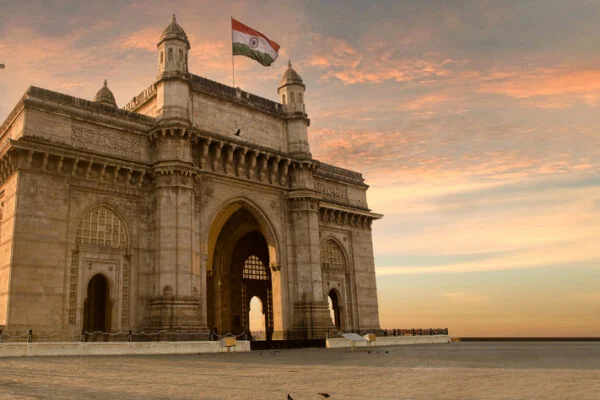Our Latest Blog

Gateway of India, Mumbai: The Majestic Portal to the City of Dreams
Gateway of India
"A witness to history, an emblem of grandeur—where the Arabian Sea kisses India's pride."
The Gateway of India, an iconic landmark known as one of the most famous attractions represented by the vibrant city of Mumbai, stands proudly majestic and majestically on the picturesque Apollo Bunder waterfront, where it overlooks the limitless horizon of the Arabian Sea. Built during the British Raj, this magnificent arched monument, with its impressive structure and historical significance, has carved a place for itself as the symbol of the city, welcoming thousands of visitors and tourists from all over the world. But it is not just a tourist landmark; the Gateway has also stood silent witness to many historical events, welcoming architectural wonders and cultural confluences that symbolize the vibrant tapestry of the city’s multicultural heritage.
Location:
- City: Mumbai
- State: Maharashtra
- Taj Mahal Palace Hotel, Apollo Bunder, near Colaba
- Accessibility: Easily accessible from Elephanta Caves by local train (CST or Churchgate), taxi, BEST bus and ferry.
Historical Background
- The Gateway was built as a grand monument to commemorate and celebrate the historic visit of King George V and Queen Mary to India in 1911. But interestingly, construction actually began two years later, in 1913, and was completed much earlier, in 1924.
- Professionally designed by the accomplished architect George Wittet, the monument was conceived and conceived as a grand ceremonial gateway to British India, a symbol of its grandeur and glory.
- Ironically, it was also the point of departure of the last British troops when India became independent in 1947.
Architectural significance
- Style: Indo-Saracenic style with influences from Hindu, Muslim and European Gothic styles
- Materials used: Yellow basalt and reinforced concrete
- Height: 26 metres (about 85 ft)
- Design features:
- Central dome with detailed latticework
- Four turrets.
- Impressive arch adorned with ornate carvings and marine motifs
Significance and Symbolism
- An important metaphor for the complex story of colonial history, as much as the incredible resilience shown by the Indian people.
- A place of remembrance and honour for India's freedom struggle
- Commonly seen in other films, books and media, this symbol is an important image of the city of Mumbai.
Common tourist attractions in the area around the Gateway
- Elephant Caves: Take a scenic ferry ride to visit this world-famous UNESCO World Heritage Site, famous for its stunning rock-cut temples, which are a testament to incredible craftsmanship and historical significance.
- Taj Mahal Palace Hotel: Iconic luxury hotel with a rich history
- Colaba Causeway: Famous for street shopping, art and cafes
- Marine Drive: A picturesque walkway for an evening stroll
- Prince of Wales Museum (Chhatrapati Shivaji Maharaj Vastu Sangrahalaya): A museum of the colonial era nearby
The surrounding atmosphere and environment of cultural and social aspects.
- A crowded place surrounded by street vendors, photographers, artists and locals
- A place for public gatherings, festivals and national events
- In many parts of the area, colorful street performances and mesmerizing live music can often be seen which complement the atmosphere.
Best time to visit
- Season: October to March (good weather)
- Time: Early morning or late evening for the most amazing views and photos
- Special events: Independence Day, Republic Day and festive New Year's Eve celebrations.
Popular and well-known local dishes are available within easy reach.
- Bademia: A very popular and prestigious food stall that offers mouth-watering kebabs and succulent rolls.
- Leopold Cafe: A famous cafe with a past linked to the colonial era and novels like Shantaram.
- Cafe Mondegar: Famous for music, beer and old-fashioned charm.
- Street food: Vada Pav, Bhel Puri, Sev Puri, ice balls and fresh coconut water.
Travel tips and guides for an easy trip.
- Keep your camera close by for amazing sunrise/sunset shots.
- Beware of crowds during peak hours.
- Drink plenty of water and avoid street food if you are sensitive to spicy food.
- Consider adding to your experience with an amazing boat tour or an interesting walking tour through the lively parts of South Mumbai.
Interesting and Impressive Facts
- Known as the “Taj Mahal of Mumbai” due to its grandeur
- Originally conceived as a ceremonial and official gateway for distinguished visitors arriving by sea
- Before the Gateway, the region we are referring to was commonly known as a fishing village.
- Illuminated with magical lights at dusk, it becomes an extremely romantic and visually appealing spot that is ideal for photographs.
The Gateway of India is an iconic landmark, which stands beyond the definition of being just an architectural wonder – it is an eloquent testament to the rich layers of India’s long, rich history, its complex colonial past and its vibrant vibrancy today. Whether you are a history buff, a photographer with a camera in hand, a foodie with taste buds, or seeking spiritual awakening, this great monument is sure to offer a rich and unforgettable experience to everyone who sets foot here. Walking here is not just about seeing a monument; it is about immersing yourself in and experiencing the heartbeat and pulse of Mumbai itself.
Your Mumbai journey begins here - at the legendary gateway, where dreams, glorious history and the endless sea blend in perfect harmony.